
Metrolinx Releases Technical Background on New Stations
Urbantoronto.ca
April 16, 2018
Robert Mackenzie
Last week, Metrolinx released a technical background report on its plan to build new GO Transit stations in the Greater Golden Horseshoe area along the Barrie, Kitchener, Lakeshore East, Lakeshore West and Stouffville rail corridors.
In February, the regional transit agency announced that it would build 12 stations to support its future regional express rail (RER) service and the City of Toronto's SmartTrack proposal. With RER, GO would offer passengers all-day, two-way, everyday service with trains arriving in stations at least every 15 minutes along most of its rail lines. The SmartTrack plan, which then-candidate John Tory originally developed during his successful election campaign for Toronto mayor, proposed even more frequent service along the Stouffville, Lakeshore East and Kitchener GO corridors.
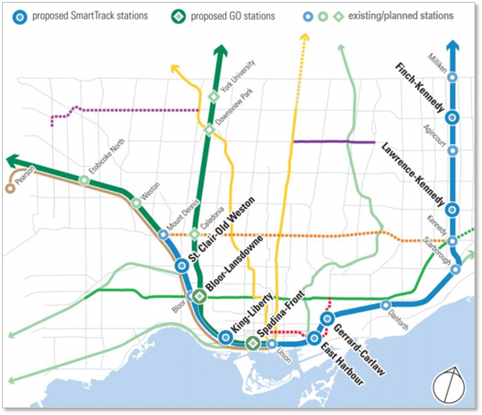
SmartTrack adds six new stations on GO Transit rail lines. Regional express rail requires two more in Toronto, image, City of Toronto
In 2016, Metrolinx completed the initial business cases for possible stations at 19 sites throughout the Greater Golden Horseshoe area. In June of that year, its board of directors approved proceeding with 12 of those stations, basing its decision on those initial business cases. Six stations are SmartTrack stations -- Finch-Kennedy, Lawrence-Kennedy, Gerrard-Carlaw, East Harbour, King-Liberty Village and St. Clair-Old Weston Road. The other six would serve general GO train passengers at Breslau (just east of Kitchener), Innisfil (south of Barrie), Mulock (in Newmarket), Kirby (in Vaughan) -- and Bloor-Lansdowne and Spadina-Front in Toronto.
Since reviewing the initial business cases, Metrolinx has proposed "three key policy, infrastructure and operational advancements" that positively impacted the stations' benefits during the next stage of planning.
Those changes include:
- operating express trains -- Trains from the outer ends of each line would operate express along the inner parts of the line. For example, on the Stouffville corridor, trains might pick up passengers at all stations between Lincolnville and Unionville, then operate with few stops between Unionville and Union Station. Local trains would serve all stops south of Unionville. This means that building new stations no longer penalizes "upstream" passengers -- those commuting to and from locations beyond each new station.
- introducing level boarding -- Passengers could board from platforms that are level with the trains. If commuters no longer have to have to step up into or step down out of coaches, then Metrolinx could further reduce the time that trains have to dwell in stations by at least 30 seconds.
- integrating fares -- Metrolinx now assumes that fares for both regional and local transit agencies would be equal and that passengers would not have to pay extra to transfer between systems. This would attract even more passengers to the new stations, especially in Toronto, because TTC and GO fares would usually be the same. (Although Metrolinx may also consider fares by distance or fares by zone.)
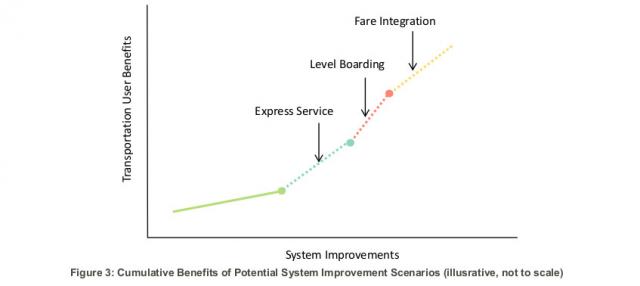 As Metrolinx analyzed each improvement, it found that benefits to passengers increased, image, Metrolinx
As Metrolinx analyzed each improvement, it found that benefits to passengers increased, image, Metrolinx
The initial business cases for new GO stations did not support a stop at Park Lawn due to its location near Mimico GO Station. However, the station could significantly improve transit for the growing Humber Bay Shores area and future employment or residential developments nearby. So, Metrolinx is starting to review this site and may add its name to its list of future stations. If this station proceeds, Metrolinx would likely split Lakeshore West service so that some trains would stop in Mimico only, while others would only serve Park Lawn.
The latest Metrolinx report details the overall modelling approach that staff used to analyze the business cases for these stations and others. It explains that each of the new stations both positively and negatively affect passengers. On the plus side, adding new stops saves time for passengers who work or live near the new stations and no longer have to travel a longer distance to trains. The new stations would attract both new passengers commuting to areas near the stations and current riders who live or work nearby, but currently use stations further from their destinations or travel origins.
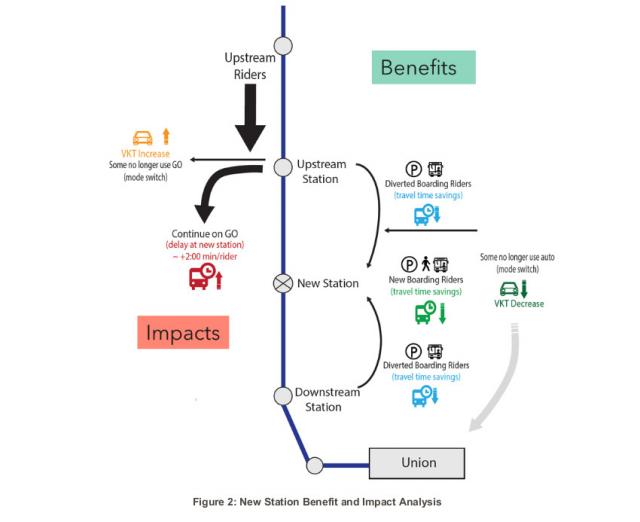 The benefits and impacts of new stations on GO rail lines and passengers, image, Metrolinx
The benefits and impacts of new stations on GO rail lines and passengers, image, Metrolinx
Another benefit of new stations would be to decrease the number of cars in the region during rush hours. By building more stations, Metrolinx would receive new passengers who previously drove to and from destinations. By decreasing the amount of regional "automobile vehicle kilometres travelled" (or VKT), new stations would help improve the environment, reduce congestion and decrease each commuter's costs for operating a vehicle.
On the other hand, new stations also negatively impact passengers, by lengthening travel times as trains stop to drop off and pick up passengers at more stations. The extent of the impact depends on each new station's location on the rail network. For example, stations closer to Union Station would have a greater impact than those near the outer end of the lines. That's because the trains at inner-network stations are full, while trains at outer stations carry fewer riders.
Adding more stops to each line may also have the opposite effect for drivers. The longer trips may discourage potential passengers from travelling by GO and encourage them to switch to driving their cars for their entire journeys.
The technical Metrolinx report explains that forecasting the number of riders and analyzing the economic impact of new stations relate to the overall service planning for GO's expansion program. Ridership depends on the service that the agency provides. Service planning and fleet size depend on the ridership. Infrastructure requirements depend on the service levels that the agency intends to provide.
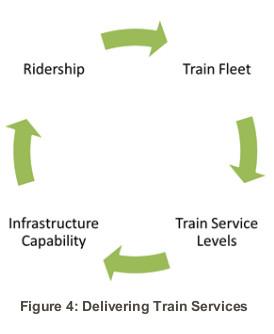
Service levels, fleet size, infrastructure requirements and ridership are inter-related, image, Metrolinx
Metrolinx service planning staff used a modelling tool which they have developed from standard transit planning practice plus information they gathered from surveys and data on present and future land-use patterns which local municipalities supplied. They modelled the new stations individually and all together to forecast future travel demand and determine how the new stations would affect current and future passengers. They also considered how several new stations on a single line would affect that line.
The staff assumed the 15-minute or better service levels for all stations at all times of the week on the busiest sections of five of the seven GO lines. In modelling the new stations, they also added express service to the mix of data. According to the report, Metrolinx always assumed that express trains would operate along the Kitchener and Lakeshore lines. The most recent forecasts also included express service along the Barrie and Stouffville rail corridors.
The resulting data show the possible service levels for each of the new stations and the number of riders likely to use the stations. Although the 15-minute-or-better service-level target remained in place, some stations (Gerrard-Carlaw, East Harbour, Liberty Village, and St Clair/Old Weston, for example) would score even more frequent service because trains operating along several lines or both local and express trains stop there.
The "SmartTrack" stations might end up with even more service, with the City funding that extra service. This Tuesday, April 17, the City's Executive Committee will consider a staff report that proposes, among many other details, an 8.5-minute frequency during the morning rush hours for stations such as Finch -- Kennedy and Lawrence -- Kennedy.
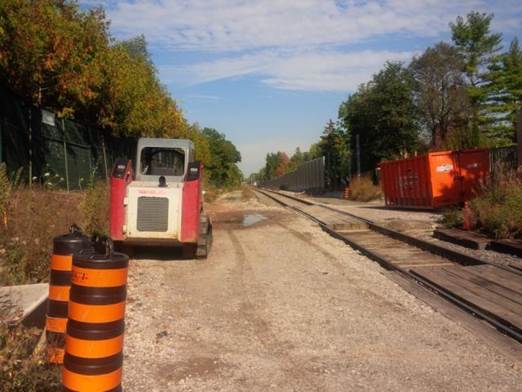
RER / SmartTrack construction along the Stouffville corridor near Havenwood Road last fall, image, Robert Mackenzie
Earlier this month, Metrolinx and Infrastructure Ontario issued a request for qualifications for its overall program of expanding GO's rail service. The RFQ is the first step in the process of finding a team to deliver the complex plan, including designing, building, financing, maintaining and operating the service. Proponents would set out the final train frequency, schedules and passenger levels they would achieve within Metrolinx guidelines, if Metrolinx awards them the contract. The successful bidder would also help determine how to achive level boarding -- whether by reconstructing station platforms or redesigning coaches or both.
What do you think of the plans for new stations? Join the discussion by leaving your comments in the form below this page, or participate in our SmartTrack and GO Transit service forums.
